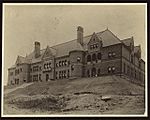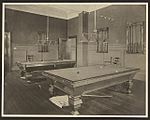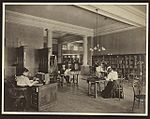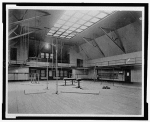Carnegie Library of Homestead facts for kids
Quick facts for kids Carnegie Library of Homestead |
|
|---|---|
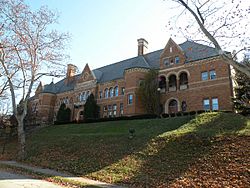 |
|
| Country | United States |
| Type | Public |
| Established | November 5, 1898 |
| Location | 510 East 10th Ave Munhall, PA 15120-1910 |
| Collection | |
| Size | 34,000 |
The Carnegie Library of Homestead is a public library that was started by Andrew Carnegie in 1898. It's a special place that offers more than just books! It also has a music hall and an athletic club with a swimming pool.
This library is one of many "Carnegie libraries" built around the world. Andrew Carnegie, a very successful businessman, believed in giving back to communities. He helped build 2,509 libraries worldwide, with 1,689 of them in the United States. The Homestead library was the sixth one he started in the U.S. and the seventh to open. It's also one of the oldest Carnegie libraries that is still open in its original building today.
The library is independent and not part of the Carnegie Library of Pittsburgh. It has over 34,000 items in its collection. The building also includes the "Carnegie Library Music Hall," which seats 1,047 people, and an athletic club with a heated indoor swimming pool.
A Look Back: The Library's Story
The Carnegie Library of Homestead was built on a hill in Homestead, Pennsylvania (now called Munhall). It overlooked the Homestead Steel Works, a large steel factory. This factory was the site of a big worker protest in 1892, known as the Homestead Strike.
Andrew Carnegie had thought about building a library for the workers for a few years. He had already built the Carnegie Free Library of Braddock for workers at another one of his factories. Carnegie believed that providing places for learning and recreation was important for his workers.
Construction for the Homestead library began in April 1896. The project cost $300,000, which was a lot of money back then! The building was designed by Pittsburgh architects Frank Alden and Alfred Harlow. They used a beautiful French Renaissance style. The building is quite large, measuring 220 by 132 feet.
Even with some updates over the years, the building still has its original layout. It keeps the three main parts separate: the library, the music hall, and the athletic club, all under one roof.
Most Carnegie libraries needed local communities to help pay for their running costs. However, Homestead was one of the few exceptions. The libraries in Braddock, Homestead, and Duquesne were originally paid for by Carnegie's factories in those towns. After he sold his business in 1901, Carnegie set up a special fund of $1 million to support these three places. Today, the Homestead library is the only one still receiving money from this original gift.
USX Corporation, a company that took over from U.S. Steel, continued to support the library until 1988. After that, the Borough of Munhall took over responsibility. Even though the Homestead Steel Works closed two years earlier (which meant fewer jobs and less tax money), the library stayed open. It did this with help from community volunteers, special grants, and money earned from Carnegie's fund. When the financial crisis in 2008 reduced the fund's value, the library board worked hard to keep services going. They raised money, sold athletic club memberships, rented out the music hall, and sold concessions to keep the library running.
Sports and Olympians at the Club
The Homestead Library & Athletic Club was famous for its sports teams in the early 1900s. Its football team was considered one of the best semi-professional teams in the country. Many former college star players joined the team. Even a famous baseball player, Rube Waddell, who is in the National Baseball Hall of Fame and Museum, played for the Club's baseball team! The amateur teams at the library also won national championships in wrestling and track and field.
The library's swimming pool was a training ground for amazing athletes. In the 1920s and 1930s, four future Olympians trained there:
- Susan Laird swam in the 1928 Summer Olympics and won a gold medal with her relay team.
- Josephine McKim won a bronze medal in 1928 and a gold medal in 1932.
- Anna Mae Gorman competed in the 1932 Summer Olympics when she was only 16.
- Lenore Kight won a silver medal in 1932 and a bronze in the 1936 Summer Olympics.
Anna Mae Gorman first swam at the library in 1927. She bought a three-month membership for just $1! She continued to swim there for many years, even at age 92 in 2008.
Andrew Carnegie himself said about the Homestead Library:
The building has rightfully in the center as the focus 'The Library'-- Music Hall upon the right and the Working Man's Club upon the left. These three foundations from which healing waters are to flow for the Instruction, Entertainment and Happiness of the people. Recreation of the working man has an important bearing upon his character and development as his hours of work.
—Andrew Carnegie on the Homestead Library
See also
- 1900 Homestead Library & Athletic Club football team
- 1901 Homestead Library & Athletic Club football team
Images for kids



